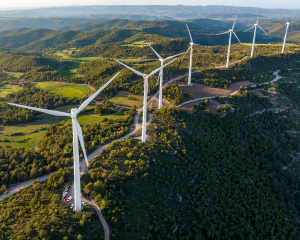The universe of climate strategies available to investors is diverse, ranging in scope and focus from portfolio decarbonization to offering exposure to climate solutions and clean energy. The environmental impact of these strategies can vary because of the different sector composition of the underlying holdings. Providing transparency into climate funds’ holdings may be pertinent for investors evaluating climate strategies such as reducing a portfolio’s financed emissions and financing low-emissions solutions.
In recent years across both public and private markets, there has been a surge in funds with climate-related names[1] (referred to as “climate funds”[2] throughout this blog post). We looked behind the names to highlight fundraising trends, sector composition and the key underlying asset classes.
The green rush is underway
The growth of climate funds in the public space has become established in recent years, with almost a decade of fund launches since the 2015 Paris Agreement. There are now more than 1,300 funds globally with assets under management (AUM) of over USD 500 billion. Over 70% of public climate funds in the market were launched between 2020 and Q3 2023, representing almost 80% of AUM.
In private markets, there was a total of 173[3] private-capital funds with climate-related names, accounting for a cumulative capitalization[4] of about USD 90.5 billion, as of Q3 2023 and before COP28. The climate funds that were launched between 2020 and Q3 2023 alone outweighed funds launched in the previous nine years combined, representing nearly 73% of the USD 90.5 billion cumulative capitalization and about 43% of the total count.
The recent rush in climate funds
Same names, different outcomes
As of Q3 2023, about 64% of the aggregate net asset value (NAV) across private climate funds had exposure to the sub-industries best positioned to benefit from the net-zero transition, in what are otherwise carbon-intensive sectors — utilities and industrials.[5] Within utilities, renewable electricity alone accounted for about 41% of NAV. For industrials, which accounted for nearly 21% of NAV, exposure was mostly in heavy electrical equipment (5.1%), environmental and facilities services (4.9%) and electrical components and equipment (3.0%).
In the public space, information technology and industrials dominated, largely through low-carbon ETFs and mutual funds that invest in companies with reduced carbon intensity or carbon footprint relative to a benchmark, along with a relative underweight to carbon-intensive sectors. Exposure to the utilities sector accounted for less than 6% on an asset-weighted basis in public climate funds.
Private climate funds concentrated in high-emitting sectors
Infrastructure and venture capital in private funds, equity in public funds
Infrastructure funds accounted for the largest portion of private climate funds, representing nearly half the cumulative capitalization and about one-quarter of the count, as of Q3 2023. Infrastructure funds’ heavy presence may reflect the outlined investment concentration in renewable electricity and industrials. Meanwhile, venture-capital funds have emerged as a key player in climate investing, accounting for 29% of the fund count — more than double the combined count across the rest of private-equity funds. Over half of venture-capital funds’ NAV in this subset was in early-stage companies, with over half of these companies operating in the industrials and materials sectors. In the public space, equity was dominant, accounting for 85% of climate funds, while debt remained mostly absent and green-bond funds largely servicing this space in public markets.
Private vs. public climate funds by asset class; debt underrepresented in both
Bridging the gaps to greener pastures
Transparency into climate funds’ holdings may help investors evaluate climate strategies such as reducing a portfolio’s financed emissions and financing low-emissions solutions. As well as understanding the underlying holdings of climate funds, further disclosures may be necessary across different sustainability dimensions. New market-based initiatives have emerged to provide climate transparency that may help channel more capital in this space. The ESG Integrated Disclosure Project[6] is one example of an initiative that could encourage more consistent private-market disclosure and facilitate material comparison between various strategies for climate investment.




